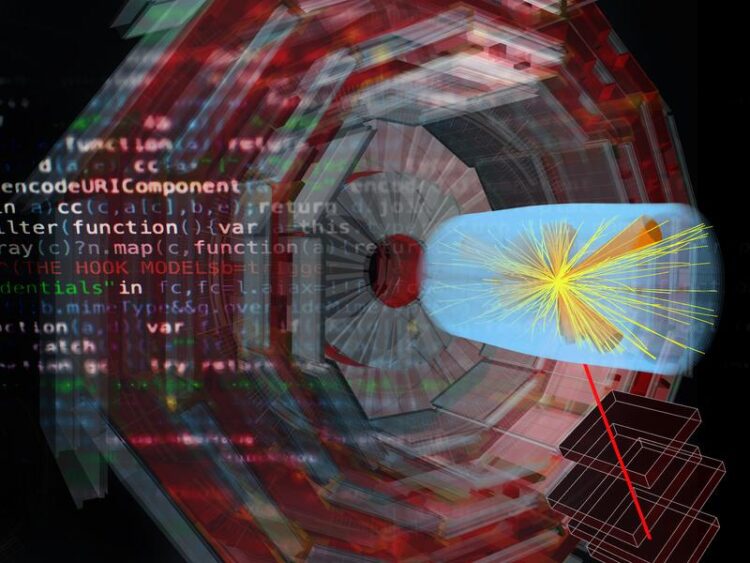Seeking a faster pathway to synthetic data

Surrogate models of neural networks in high energy physics: The use of neural networks could considerably accelerate the production of synthetic data sets in high energy physics with all physical boundary conditions.
© CASUS/2021 CMS Collaboration
Helmholtz Association funds project for data acquisition using neural networks.
In addition to experimentally generated data, fundamental research in physics also works with synthetically generated data. Acquisition of such data with currently available simulation methods is, however, time consuming and ties up immense computer capacity. A new project by DESY, the Helmholtz-Zentrum Dresden-Rossendorf (HZDR) and the Center for Advanced Systems Understanding (CASUS, Görlitz) at the HZDR, is testing an approach with which data on physical systems behavior can be generated more quickly using neural networks. The “SynRap” project was selected for funding through a competitive process.
The fifteen winning teams are to receive a total of 6.2 million euros over the next few years to carry out their projects through the Helmholtz Association’s Artificial Intelligence Cooperation Unit Helmholtz AI.
Synthetic data are data generated by computer algorithms. They are used, for example, to test software or to pass on anonymized personal data. The training of machine learning algorithms is another important field of application. Here, synthetic data are needed primarily for training deep neural networks–a specific type of computer algorithms from the domain of artificial intelligence. Dr. Isabell Melzer-Pellmann, group leader at DESY, explains, “These algorithms must be trained with particularly large data sets in order to produce accurate results when analyzing experimental data.” Currently, these training data are created with complex numerical simulation methods from the field of quantum mechanics. These methods are, however, computationally intensive and consume a great deal of computation time.
A faster alternative will now be studied within the project “SynRap – Machine-learning based synthetic data generation for rapid physics modeling.” The aim of Melzer-Pellmann and her colleagues Dr. Dirk Krücker from DESY, Dr. Attila Cangi from CASUS and Dr. Nico Hoffmann from the Institute of Radiation Physics at HZDR is to accelerate the process of producing large amounts of synthetic data by a factor of one thousand. To do so, the team plans to compile a toolbox of machine learning algorithms suitable for this purpose. These algorithms stem from a particular subset of neural networks. In contrast to deep neural networks, they are called surrogate neural networks.
The quality of the data sets created in this way will be assessed by applications from the research areas high energy density physics and high energy physics. High energy density physics focuses on phenomena in the interior of planets and stars as well as on applied research, such as the processing of materials with powerful lasers. High energy physics tackles fundamental questions concerning the nature of our universe: What is matter made of? What laws determine interactions of the components of matter?
One toolbox – many areas of application
“The unique feature of our project is that our toolbox of various neural networks should ultimately find use in many research areas,” explains Cangi. This is why the needs of other natural sciences will also be taken into consideration when developing the software tools. “The interdisciplinary nature of CASUS enables us to orient our work on typical user scenarios from the environmental sciences, systems biology, and others,” adds Cangi.
The Helmholtz Artificial Intelligence Cooperation Unit (Helmholtz AI) strengthens the application and development of applied artificial intelligence and machine learning. Within the Helmholtz AI competition, a panel of experts selected in particular those research projects that promise a high gain in insight. However, such projects are also considered especially risky. There is a good chance that unsolvable problems will arise and the outlined project objective will not be achieved. The Helmholtz Association is awarding a total of 6.2 million euros in the current funding cycle. During the first Helmholtz AI call a year ago, nineteen projects were awarded a total of 7.2 million euros.
Wissenschaftliche Ansprechpartner:
Dr. Michael Bussmann | Scientific Head
Center for Advanced Systems Understanding (CASUS) at HZDR
+49 3581 375 2311, +49 351 260 2616| m.bussmann@hzdr.de
Dr. Attila Cangi
Center for Advanced Systems Understanding (CASUS) at HZDR
+49 3581 375 23 52 | a.cangi@hzdr.de
Dr. Nico Hoffmann
Institute of Radiation Physics, HZDR
+49 351 260 3668 | n.hoffmann@hzdr.de
Dr. Dirk Krücker
DESY
+49 40 8998 3749 | dirk.kruecker@desy.de
Dr. Isabell Melzer-Pellmann
Head of the DESY-CMS (Compact Muon Solenoid) group, DESY
+49 40 8998 2489 | isabell.melzer@desy.de
Prof. Dr. Ulrich Schramm | Director
Institute of Radiation Physics, HZDR
+49 351 260 2471 | u.schramm@hzdr.de
Weitere Informationen:
http://www.casus.science CASUS website
http://www.helmholtz.ai Helmholtz Artificial Intelligence Cooperation Unit
Media Contact
All latest news from the category: Information Technology
Here you can find a summary of innovations in the fields of information and data processing and up-to-date developments on IT equipment and hardware.
This area covers topics such as IT services, IT architectures, IT management and telecommunications.
Newest articles

Why getting in touch with our ‘gerbil brain’ could help machines listen better
Macquarie University researchers have debunked a 75-year-old theory about how humans determine where sounds are coming from, and it could unlock the secret to creating a next generation of more…

Attosecond core-level spectroscopy reveals real-time molecular dynamics
Chemical reactions are complex mechanisms. Many different dynamical processes are involved, affecting both the electrons and the nucleus of the present atoms. Very often the strongly coupled electron and nuclear…

Free-forming organelles help plants adapt to climate change
Scientists uncover how plants “see” shades of light, temperature. Plants’ ability to sense light and temperature, and their ability to adapt to climate change, hinges on free-forming structures in their…





















